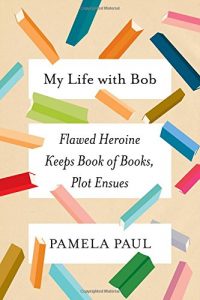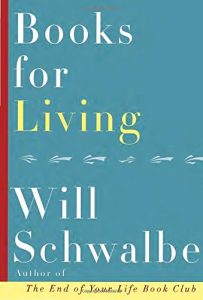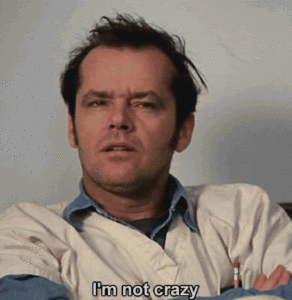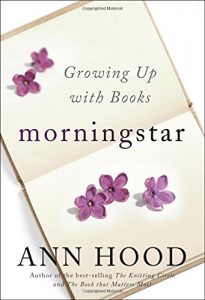Books of books
There’s an endless number of books about books and I gravitate to them like a moth to flame. As I’ve said before on this blog, it’s a sickness I tell you, and I just can’t help myself.
This intrigue, for me anyway, is all in the shared pleasure. What are others reading? What books have they liked, nay loved? Please discuss. How do they read – favorite nook, coffee shop, bed? Tell me more. How do they keep track and record their thoughts on the books they’ve read?
But most interesting is why people read.
Over the last few months (in between other reading), I’ve devoured three such reads, from different authors, and each with different viewpoints on the importance of books and reading in their lives.
+++++++++++++++++++++++++++++++++++++++++++++++
 My Life with Bob, by Pamela Paul
My Life with Bob, by Pamela Paul
Ms. Paul is the editor of the New York Times Book Review and has keep ‘Bob’ — her Book Of Books — by her side since high school. How could I not instantly like someone who has kept a journal of everything she has read for 28 years? Talk about kindred spirits.
My Life with Bob is a memoir, cum literary critique with short chapters that reflect on a childhood where being “such a reader” proved to be sometimes lonely and to college where she berates herself for not having read Trollope or the Greek plays – “oh, the shame of being under read”.
Each chapter recounts pivotal points in her life, from divorce to the death of her father, where reading gave her strength, encouragement, solace or just plain escapism. She charts her life through her list of books in Bob and sees how she was formed by reading– from finding herself as a teenager through books, to ultimately a career in the book trade.
In my Book of Books, I can see the way these choices line up and read the signs along the way that reveal those decisions. Here, a novel selected with deliberation; the next, a matter of circumstance. This one was assigned, but that one a book I was dying to read. My mother-in-law gave me that book. This other one was found in the common room of a New England bed-and-breakfast. All of those choices.
Ms. Paul is funny and poignant and I found myself chuckling with her insights and admissions. After an easy, uncomplicated birth, she arranges to stay an extra day in the hospital, just so she could finish her book.
Ms. Paul takes us on her journey to becoming a major player in the book review world and how when overjoyed at a promotion from children’s book editor to chief editor of the Book Review, her children were dismayed and thought she’d been demoted.
My Life with Bob is for anyone who is a reader before almost anything else and will inspire you to start keep track of your reading thoughts.
I only wish I kept a book of books since high school. Alas, my written records only go back to 2000, when a dear friend gave me my first book journal. But I have happy memories of my early reading and the books I loved — My Friend Flicka, Anne of Green Gables, Beautiful Joe, Heidi and, of course, Little Women.
But I digress, here we go with some more books to add to your reading list.
+++++++++++++++++++++++++++++++++++++++++++++++
 Books for Living, by Will Schwalbe
Books for Living, by Will Schwalbe
Mr. Schwalbe, is the author of the best seller – The End of Your Life Book Club, which documents the books he and his mother read as she lay dying in the hospital. (Resisted reading it, thought it might be too heartbreaking, but now maybe I’ll give it a try.) The author now takes to the page to address how books can fit with the the noise and distractions of our modern world.
In his introduction he writes that reading is “a respite from the relentlessness of technology” and that at the heart of our over-connectiveness is fear —
–fear that we are missing out on something. Wherever we are, there’s someone somewhere doing or seeing or eating or listening to something better.
He goes on to surmise that this brings on a loneliness that separates us from ourselves — and that by reading we can open our minds and grow into our own possibilities of life and living. (Not to mention a un-plugged hike in nature.)
Each chapter covers a topic in which books and reading played a key role in his life. Everything from ‘Embracing Mediocrity’ to ‘Admiring Greatness’ — there’s a beautiful chapter on loosing a childhood friend and how re-reading David Copperfield and his loss of Dora gave him comfort.
Mr. Schwalbe introduced this reader to the Chinese philosopher Lin Yutang and his famous book, The Importance of Living “is about the need to slow down and enjoy life. And, it is about the importance of books and reading.” (Don’t worry, it’s been added to my TBR list.)
It is clear that the author carries his heartbreak with him — the loss of his mother and dear departed friends:
We can’t do much for the people we’ve lost, but we can remember them and we can read for them: the books they loved, and books we think they might have chosen.
Mr. Schwalbe covers a wide range of books from many genres — The Odyssey, The Girl on the Train, The Little Prince, and one of my favorites, Anne Morrow Lindberg’s – A Gift From the Sea. He even finds a place in his reading life for cookbooks, like me, he recognizes they can be far more than just recipe collections.
The appendix for Books for Living lists just over 150 authors, books, plays, poems, stories, and journal articles which Mr. Schwalbe references in Books for Living. You definitely be adding books to your own TBR list. A most enjoyable read for any bibliophile.
While Mr. Schwalbe and I share much when it comes to reading, I was delighted that he is also considered odd — as we both are known to start conversations with — “What are you reading?”
An advanced reading copy was provided by Alfred A. Knopf
+++++++++++++++++++++++++++++++++++++++++++++++
This delightful little book tells of Ms. Hood’s coming of age and how reading shaped her. She breaks the book into ten chapters or lessons — each centering on a book that changed her outlook, built new dreams, or taught her valuable lessons.
The first chapter, or Lesson 1, is entitled How to Dream, and centers on Marjorie Morningstar by Herman Wouk. (Thus the title “Morningstar”.) Ms. Hood read the book as a teenager trapped in a Rhode Island mill town. Marjorie Morningstar allowed her to dream of something bigger. She re-reads it every year:
Maybe that’s why I reread it every year. Maybe, as time beats me up and grief or loneliness or a new kind of bittersweet melancholy take hold, I need to remind myself to keep going, keep reaching, to not forget the girl who believed she could have everything and anything at all.
Like the other two books on books, I felt a kinship Ms. Hood, but this time because of our similar ages. I found myself recognizing her descriptions of growing up in the 60’s & 70’s — with the Viet Nam war on television, girls-only home economics classes, and listening to Simon and Garfunkel. There was the confusion of the world breaking open with the women’s movement, communes, hippies, civil rights — all contrasted with our girl scout activities and mothers having dinner ready for dad’s homecoming each day. We were both girls who hid from this confusion by escaping into the other world(s) of books.
Upon being discovered secretly reading Little Women during class, her elementary school teacher asks her to stay at recess:
“You’re reading Little Women?” she asked, looking at the book in my hands. I nodded. “And you understand it?”, she asked. Again I nodded. Then she asked me tell her what the book was about. At this, I began to talk, about Marmie and the March sisters the plays they put on, about Laurie next door and vain Amy and Jo who wanted to be a writer and how Beth died. I told her it was about family but also about war and dreams and writing and…”And”, I said, “everything. It’s about everything.” Now it was Miss Nolan who nodded. She paused, then pointed to the books that lined the bookshelves in the back of the classroom. “I don’t want you to go out to recess anymore”, she said. “I want to you to stay inside and read all those books”.
(I never had the fortune of such a teacher letting me skip recess or P.E. – sighs of envy.)
Ms. Hood grew up without books at home, and she tells of going to the local library and checking out whichever books were the biggest, (Anna Karenina, Les Miserables) so she could get the most reading per book. There’s a section where a bookstore opens in a mall close by and she revels in the possibility to buy and own a book of her very own.
In Lesson 8: How to Have Sex, Ms. Hood recounts reading The Harrad Experiment which opened her mind about sex and the sexual revolution — where sex didn’t have to become intertwined with love and marriage. (I vaguely remember reading a borrowed copy in high school, and found it both embarrassing and eye opening.)
Ms. Hood could be describing many bookish children growing up, we all felt this way at one time or another:
How can I describe what reading gave to me? An escape from my lonely school days, where girls seemed to speak a language I didn’t understand. A glimpse into the possibilities of words and stories. A curiosity about the world and about people – the young Amelia Earhart seeing her first plane, Helen Keller’s silent world, Nancy Drew solving mysteries, David Copperfield surviving the streets of Victorian London.
But, fear not, the author enjoys pure pleasure reading:
Even now I like to sometimes indulge in the guilty pleasure of reading a book that literary snobs would never consider reading. And I enjoy them, those paperbacks I don’t mind leaving behind on an airplane. They make long flights pass pleasantly. I don’t have to marvel at the use of language or metaphor or puzzle over how the author pulled off such a mind-bogglingly intricate plot. I just read it and forget it, perhaps a habit I learned back in high school when I read any book I could get my hands on.
Morningstar is a lovely book and it reminds us that books can form a childhood – give escape from confusions – spark dreams of bigger things and open us to other worlds.
A digital advanced readers copy was provided by W.W. Norton & Company via NetGalley.
+++++++++++++++++++++++++++++++++++++++++++++++++
So there you go, BookBarmy fans, three more books about books to re-read, books you haven’t read, books you need to read, books you may want to read, books to consider reading…
But, no, no I’m not crazy… really.. 






